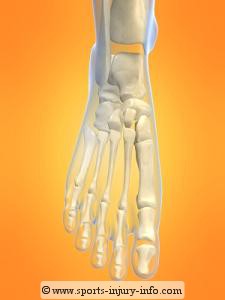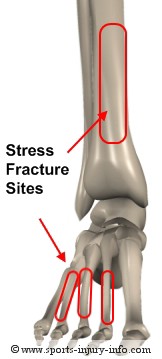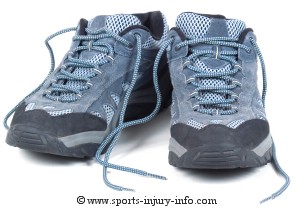Stress Fractures

Stress fractures are pretty common with sports. There are lots of different things that may contribute to the development of this injury. And treatment can be tricky at best if you don't know what to look for.
Read on to find out more about this injury, how it occurs, symptoms, and prevention.
What is a Stress Fracture?
It is different from a normal fracture in that there isn't actually break in the continuity of the bone. In order to understand what a stress fracture is, we have to look at how normal bone functions.Bone, unlike soft tissue, is in a constant state of renewal. Everyday you have bone cells that are broken down by the body, and replaced with new bone cells. This is the normal process. The amount of stress that is placed on the bones everyday helps to determine how much bone is broken down, and how much is replaced.
This is why weight bearing exercise is recommended for good bone health. The more you exercise, the stronger your bones get as they adapt to the stress.
The problem with this is that sometimes, when the stress is too great, the bone breaks down more than it rebuilds. This causes an area of weakening. Which is really what this injury is. An area of weakening within the bone, due to excessive stress.
What Causes a Stress Fracture?
The most common cause of this injury is running. I have seen lots of patients with stress reactions due to running. The repetitive pounding causes a lot of stress on the bones, and sometimes it is just too much to handle. Over several weeks, an area of the bone begins to weaken, because it cannot rebuild as fast as it is being broken down.You don't have to be a runner to have a stress reaction in the bone. Any sport that requires a lot of running, like soccer or basketball, and that involves running on hard surfaces can cause this injury.
Other factors that can contribute include low bone density, poor diet and nutrition - not enough vitamins and minerals to rebuild the bones, and the biomechanics of the foot and low leg.
Common Stress Fractures

This is most likely because these bones all support the body's weight during activity, and can bear the brunt of excessive activity stress.
Symptoms
Pain is the most common symptom of a stress fracture. It usually starts off gradually, and then progresses to pain after activity, and then all the time. It usually feels like it is deep in the bone, and may be described as a burning type of pain.Pain with the landing part of running, or when you strike the ground is very common. The pain may lessen a little if you rest for a few days, but unfortunately returns immediately when you begin activity again.
How Do You Know For Sure?
How do you know if you have a stress fracture, versus some other type of injury, like shin splints You have to examine your activity levels, nutrition, and other factors. If you are putting in a lot of miles, or are participating in a lot of practice and game hours, and if your pain does not lessen with rest, you may have a stress reaction in your bone.X-rays will usually not show a stress fracture. The best test is a bone scan, which looks at how much bone is being broken down and rebuilt. An area of stress will show up as an area with lots of activity.
Your physician may recommend a bone scan if they think you may have a stress fracture.
Treatment
Unfortunately, the best and most effective treatment for this injury is rest. It is the only way to allow the bone to rebuild itself. If you continue your activity, then you will continue to weaken the bone, and it will not be able to heal. In fact, it will continue to get worse, until it gets so weak that the bone actually breaks.Most stress fractures are treated with some type of protected rest, perhaps in a walking boot. This lasts for several weeks, and then a very gradual return to activity. A hard cast is not necessary, as there isn't a true break to protect, but a walking boot allows for good protection of the injured area.
Prevention
The best way to prevent this injury is to monitor your activity. Make sure you gradually accomodate to your sport. Don't jump in and start running 5 miles a day, 7 days a week. Work up slowly and give your bones time to get stronger.Rest is also important. Your body cannot sustain levels of activity without rest for long periods of time. So, if you are a runner, take at least 2 days a week off. Give the bones time to recover, and they will thank you.
Make sure you have good athetic shoes that support your feet. And that you are running or participating on good surfaces. Try to avoid running on hard concrete every day.
Good nutrition is the final key to prevention. Make sure you eat a balanced diet, and get lots of calcium - milk, cheese, yogurt. It is very important for good bone health.
Summary
Stress fractures are common injuries, but they can be prevented. A gradual increase in activity, with planned days of rest, good shoes and proper diet are also important.Treatment focuses on resting the injured area, and allowing the bones to rebuild themselves.
Didn't find what you were looking for? Search SII for more information...
Running Pain Solutions
Written for Runners by a runner, you'll learn a holistic approach to improving mobility, restoring normal movement and muscle activation patterns, and restoring the body and mind connection.
This Kindle Book contains a step by step program to keep you running pain free. Included are detailed instructions and illustrations for exercises to improve mobility, balance, neuromuscular control, strength and endurance. Only $7.49!
Get Your Copy Today!










